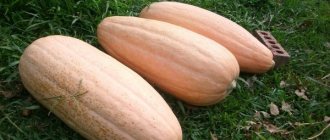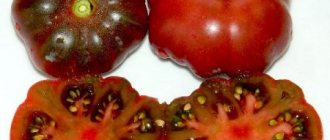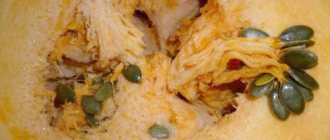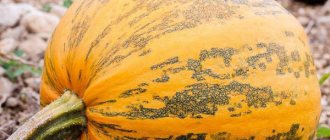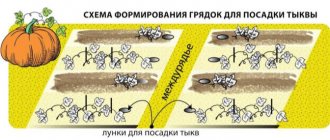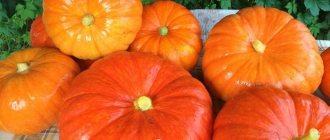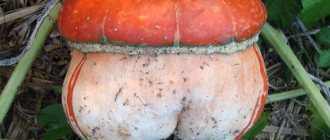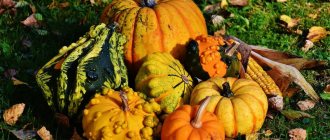“Goose in apples” is not a culinary masterpiece, but the name of an amazing vegetable of the pumpkin family, belonging to a species of the genus Lagenaria, which is also sometimes called “dish pumpkin” or gourd. India is considered the birthplace of this plant. The “goose in apples” pumpkin got its name because of the unusual appearance of the fruit, which really resembles geese with an elongated neck. You should learn more about sowing, growing and using this plant.
Description
Lagenaria is the most unusual member of the pumpkin family. This is a strong, tall, annual vine-type plant with soft green leaves. It blooms white and has large large flowers that look like a bell. The fruit has a very interesting shape: it looks like geese grazing in a meadow. The pumpkin itself is dark green with specks of white. The plant can reach a height of 12 to 15 meters. Lagenaria is able to bear fruit and bloom at the same time, without reducing the yield until frost occurs. From one bush you can remove 10-15 fruits weighing up to 1.5 kg, about 50 centimeters in length. Although some specimens can reach a weight of 8 kilograms.
Lagenaria is a dietary product. It is believed that it removes waste and toxins from the body. Only young fruits are used for food, and original kitchen utensils are made from large, ripe pumpkins by removing seeds and pulp and drying the peel until hard. Interestingly, the fruit can be removed not completely, but in parts - the cut becomes cork, and the plant continues to grow further.
Where to plant and how to care for lagenaria?
A liana from the squash family will produce the largest and most abundant harvest in a sunny place, protected from drafts. In such conditions, the bush itself will grow large and powerful, but in partial shade the leaves and fruits will be small. Decorative pumpkin prefers fertile, light soil with neutral or slight acidity.
Caring for lagenaria is simple and consists of simple and familiar procedures for a gardener, namely:
- If there is no rain, water twice a week (2-3 buckets per bush). With the beginning of autumn, when the fruits ripen, watering can be stopped.
- During the season, feed with mullein and mineral complexes, alternating them.
- If the support is not high, to limit vertical growth and stimulate branching, pinch the vines after they reach approximately 3 m in length. This procedure will not only restrain growth, but will also contribute to the setting of female inflorescences that produce a harvest.
Each lagenaria bush should have a support in the form of an arch, tree, fence or special ladder. As the bush grows, the lashes should be tied every meter and directed so that the tendrils can catch.
To get your own seed version for propagating lagenaria, you need to leave the first ovary. To increase the number of seeds in a pumpkin, it is recommended to artificially pollinate the female inflorescence with several male flowers. If the fruit did not have time to ripen before the cold weather, it does not matter - it can be cut off with part of the vine and allowed to ripen at room temperature. Good ripe seeds will be brownish in color, and they can be stored for up to 10 years with virtually no loss of germination percentage.
In conclusion, I would like to say that lagenaria is simply an extremely useful vegetable for the garden. It will create a pleasant shade in the yard, allow you to admire delicate flowers and inhale their pleasant aroma, and decorate the area with fancy garlands of original fruits, which can be used for creativity or for culinary purposes. Grow this unique plant and make all your neighbors jealous!
Germination of seeds
In order for the seeds to show high germination, it is not a bad idea to soak them for two days in growth stimulants (Epin or aloe juice). Pumpkin seeds have a fairly thick shell, so it is advisable to soak them before planting: put them in a linen napkin, moisten them with water and put them in a warm place for several days. It is necessary to ensure that the napkin remains damp. You can also use this method: after soaking, place the seeds in damp sawdust or sphagnum moss. The air temperature must be maintained at 23-24 degrees Celsius.
Features of decorative pumpkin
The most important “plus” of this amazing culture is its unpretentiousness. Even a novice gardener can grow a green “screen” with orange or yellow “lanterns” and “stars” without much difficulty. But at the same time, we must remember that the ornamental beauty is a native of warm overseas regions, so it cannot tolerate low temperatures at all: below 14-15ºC, plants slow down in growth, and at zero and -1ºC they die completely.
In the middle zone and more northern regions, it is best to grow such a crop through seedlings; then the pumpkin will delight you with its luxurious foliage, lush flowering, and incredibly beautiful fruits. The pumpkin also needs to be provided with good nutrition and regular, abundant watering. The color of flowers, leaves and, of course, fruits will be bright if the pumpkin grows in a sunny area.
If it is a climbing vine, then the plant is planted near supports, bush forms grow as usual.
Planting and care
Plants are planted at a distance of one meter from each other, preferably on the south side. To reduce moisture evaporation, the soil can be mulched. For this purpose, you can use peat or humus. At night, plants can be protected with covering material. When the lagenaria reaches one meter, it needs to be tied to a trellis, and if it is not possible to make supports, it is necessary to put boards under the stems to protect them from slugs and damp soil. The growing season for the goose-in-apples pumpkin is about 220 days. Lagenaria usually opens its flowers at night and closes in the morning, and only nocturnal insects pollinate it. Therefore, for additional pollination it is recommended to use the manual method. Fruit ripening lasts from 1.5 to 3 months after pollination. One plant can have up to 9 ovaries.
When the main stem and side shoots grow to two meters, they should be pinched, and some of the ovaries can also be removed so that the fruits are better formed. This crop responds well to feeding with organic and mineral fertilizers; regular loosening of the soil and timely weeding have a beneficial effect on it. It is also necessary to provide the plants with timely watering, which is done only with heated water.
How to grow
The variety is suitable for cultivation in all regions of Russia. In the south, pumpkin seeds are immediately planted in the ground. In other regions, seedlings are first grown indoors and then transplanted into garden beds.
Planting by seeds
To plant Lagenaria Goose in apples, lightly germinated seeds are used (for this they are placed in growth stimulants - “Epin” or aloe juice). Before planting, the seeds are soaked: placed in a cloth moistened with water and stored in a warm place for several days. It is important to ensure that it remains wet at all times. After 3-4 days, you can plant lagenaria seeds in the ground.
Important ! Preparing the soil for planting lagenaria is the same as for pumpkins and zucchini. The only difference is that the soil must be neutral or slightly alkaline.
Seeds are planted in mid-April.
One or more seeds are sown in each hole, at least 5-10 cm deep. When several sprouts appear, only one plant is left, the rest are removed. The distance between holes should be 1 m or more.
To obtain new seeds, some fruits are left on the stems until fully ripe. The seeds are then dried.
Planting seedlings
The process of preparing seeds for growing seedlings is the same as for planting in open ground. Seeds are sown in containers with a volume of at least 1 liter. Peat pots are better suited: each seed is in a separate pot. You can use a common box for planting, and then dive into separate containers. However, lagenaria does not always survive this process successfully.
Young shoots are planted in open ground in mid-May - early June, when night frosts have passed . The distance between the holes should be 1 m, and the diameter and depth of the holes should be at least 30-40 cm. First, a mixture of 2 tbsp is poured into each hole. l. ash, 500 g of humus and 2 tsp. superphosphate.
You can water the hole with Agricola-5 solution (20 g of the drug per 10 liters of water). Planting should be done carefully to avoid damage to the roots and stems. After planting, the lagenaria is watered with warm water.
Attention ! The size of lagenaria for transplanting into open ground should be at least 10 cm.
Choose a sunny, well-lit place for growing lagenaria.
A plant that reaches 1 m in height will need support.
Care
Lagenaria is unpretentious, but requires some care:
- Regular moderate watering is important;
- lagenaria flowers bloom in the dark and close in the morning (only nocturnal insects pollinate it), so it is additionally recommended to use the manual pollination method;
- during growth it is recommended to feed the plant with organic fertilizers;
- to reduce moisture evaporation, the soil is mulched with peat or humus;
- Regular weeding and loosening of the soil are required;
- the stems of the plant require timely pinching and pruning - this stimulates the growth of lateral branches and limits the growth of the main shoot;
- the plant is liana-shaped, it requires supports, which are best placed at a distance of 1.8-2 m from each other (trellis, arches, trees).
Features of cultivation and possible difficulties
For cultivation, fertile soil is used, fertilized with organic and mineral compounds. Acidified and too wet soil is not suitable. Fertilize the soil in the fall.
Lagenaria grows well after legumes, cabbage and potatoes. For planting, it is better to choose a well-lit place, not a shaded one. The plant does not tolerate frost. The optimal temperature is +25 °C.
The growing season of the Goose variety in apples is about 220 days.
When growing lagenaria, you may encounter the following difficulties:
- You may never get any fruits (or there will be 1-2 of them) if you do not use the manual pollination method. The natural overnight method is not enough.
- The fruits dry out after setting. The reason is unsuitable conditions or poor watering.
- Not all seeds planted in open ground or for seedlings can germinate. This happens because the seed skin is very dense.
- The plant may die if night frosts occur after planting in the ground.
Growing tips from experienced gardeners
Summer residents give the following recommendations for growing the Lagenaria variety Goose in apples:
- You can sow seeds for seedlings in a bag intended for preparing compost;
- To grow lagenaria, you need the sunniest place;
- to plant seedlings, you need to dig a hole measuring 40x50 cm, fill it with soil mixed with humus (a glass of wood ash and 50-80 g of Ammofoska mineral fertilizer per bucket of humus);
- fertilize with infusion of chicken manure every 10 days;
- as a support you can use wire stretched along a fence, gazebo or veranda;
- the support can be natural - a tree or bush;
- with the appearance of the first flowers, it is necessary to carry out hand pollination - pick a male flower, bring it to the female one and touch it with the stigma stamens;
- so that the “neck” of the fruit is not bent, but elongated, the fruits are hung.
Diseases and pests
Lagenaria is affected by the same diseases and pests as other members of the pumpkin family.
Diseases:
- Anthracnose . A fungal disease that appears as light brown spots on leaves and stems. Leads to fruit ulceration. High air humidity promotes the development of the disease.
- Root rot. Refers to fungal diseases. Characteristic signs are wilting of leaves followed by death of roots. The reason is the sharp changes in night and day temperatures.
- Gray rot. Large brown spots appear on the leaves, a gray fluffy coating appears on the fruits, and the stems begin to rot.
- Powdery mildew. Fungal disease. It appears as a white or reddish coating on the front side of the leaves, which leads to their drying out. The reason is excessive moisture.
- Peronosporosis , or downy mildew. Light, then brownish spots appear on the upper side of the leaves. On the underside, a grayish-violet coating is noticeable in places where there are spots.
Harvest and storage
The vegetative period of lagenaria is quite long. The fruits, which are intended for collecting seeds and for various crafts, remain on the vines until fully ripened. Only young greens with a diameter of up to 5 centimeters and a length of up to 12 cm are used for food. Ripe pumpkins are harvested before the onset of the first frost. Such fruits have a very thick and hard (like a shell) peel, which allows them to be used in decorative arts.
Lagenaria: pumpkin varieties grown in Russia
The state register of breeding achievements approved for use includes two names of lagenaria: the variety Grafin and the hybrid Machis F1.
Varieties from the breeding company Gavrish
Decanter
Lagenaria Grafin pumpkin was bred by Gavrish for private farms in all regions of Russia. However, it must be taken into account that the variety requires high temperatures for normal development. Plants do not tolerate frost at all. Therefore, Lagenaria Grafin is grown in open ground in the southern regions, and under a film in the north-west. Remember that this pumpkin requires support. She has very branched, long lashes, reaching up to 10 meters. This variety of pumpkin produces medium-sized, pear-shaped fruits. They grow weighing from 0.5 to 1.6 kilograms. The color of the fruit is light green with variously sized spots of lighter tones. The pulp is loose and not juicy. Two or three day old ovaries are eaten. They are boiled, stewed, pickled or salted. The yield of the variety is up to 3 kilograms per 1 square meter.
Other varieties from the company Gavrish
In addition to Decanter, the company has developed varieties that are not currently included in the state register of varieties. These are Dish-shaped, Hostess, Snake-shaped, Log-shaped, Club-shaped, Goose in apples. They have an unusual shape and size.
The Goose in Apples variety really resembles a spotted goose. This pumpkin is especially interesting for crafts.
Lagenaria variety Goose in apples
Lagenaria of foreign selection
First generation hybrid Macis (MACIS) F1
The first generation hybrid of Lagenaria Machis of Dutch selection is bred for the purpose of grafting watermelon. Grown to produce a rootstock, it is particularly demanding in terms of growing conditions. But it also serves as an excellent rootstock. Watermelons grafted onto Machis have enhanced growth and increased productivity. Their fruiting occurs earlier. They are less demanding on temperature conditions. This is especially important in regions with a cool climate. Lagenaria Machis, grown for its fruit, is of medium length. It has light green pear-shaped fruits up to 2 kilograms. The pulp is not juicy and loose. The hybrid is recommended for all regions of Russia.
There are many varieties of lagenaria in the world
In addition to the above mentioned varieties, other varieties and hybrids of lagenaria can be found in Russia. Its fruits can be of bizarre shapes and sizes to suit every taste.
Lagenaria fruit with wrinkled surface
Collecting seeds
According to gardeners, pumpkin seeds “goose in apples” can not only be bought, but also obtained at home. To do this, the very first fruit is left on the vines until fully ripened, then it is stored in a warm place until October. After this, the pumpkin is cut with a hacksaw and the seeds are removed - there are about 200 of them in one fruit. It is better to use paper bags to store seeds. They retain their germination capacity for 7 years, but gardeners begin to use them as planting material in the second year.
Advantages and disadvantages of the variety
The main advantages of Lagenaria Goose in apples:
- good yield;
- disease resistance;
- originality of appearance;
- refinement of taste;
- nutritional value;
- unpretentiousness;
- possibility of use for decorative purposes;
- duration of storage of collected fruits.
Disadvantages include the inability to grow a plant without heat and good light, and the need for manual pollination.
Application
This pumpkin is useful for consumption, especially for people with diseases of the kidneys, bladder, stomach, liver, as well as the heart and blood vessels. And yet, lagenaria is grown mainly for decorative purposes. They make unusually beautiful dishes, toys, smoking pipes, musical instruments, and candlesticks from it. The long and elastic stems are used in weaving, and the seeds of lagenaria are used to make oil. Bulk products are stored in dried, prepared containers, and milk is also well preserved in them.
What is lagenaria
Lagenaria is an annual climbing plant of the pumpkin family. Its homeland is India and Vietnam, which is why it is also called Indian cucumber or Vietnamese zucchini.
Lagenaria fruits are edible only when unripe. They are varied in shape: serpentine, elongated, similar to a huge cucumber or zucchini, jug-shaped, bottle-shaped, and egg-cell shaped. The color of the fruits resembles pumpkin or zucchini and can reach 2 m in length.
Lagenaria also performs a decorative function, entwining gazebos and fences. Lagenaria fruits are suitable for consumption fresh and after cooking.
Reference . Lagenaria stems are used to make baskets and other wickerwork.
How to grow healthy and strong seedlings
Like all cultivated flowers, gatsaniya requires constant care. But if an adult plant is able to remain without watering for a long time and has good immunity, then a young sprout is not particularly resistant to any disasters. Hence, following the care rules is mandatory.
Temperature, lighting and humidity
Initially, containers with gatsaniya seeds for seedlings are located in a shaded, warm place. After the sprout appears, move it to a well-lit place without drafts.
The temperature does not drop to more than 20 degrees. The ideal temperature for a flower is + 25.
Since seed planting takes place in winter or early spring, natural light is not enough for full development. It is necessary to regularly add additional lighting for 4-6 hours. Humidity is low so as not to stimulate the appearance of rot.
Watering and fertilizing
Gatsanias are not watered, but moistened with a spray bottle. The process should take place even if the seed material has not sprouted and is under cover. The standard procedure is carried out every third day.
Drying and processing
If the gardener’s task is to use the fruits to create decorative items, then he only needs to wait for the pumpkins to ripen; the hardening process will take place independently due to the sclereids that make up the bark.
The fruits are cleaned, soaked and dried. You can dry it in the fresh air or in a special oven.
After the bark has completely hardened, it can be used to make jewelry, dishes, and weave baskets.
This is an amazing plant - bottle gourd. While it is not very popular in Russia, it is gradually attracting the attention of gardeners.
Let's talk about varieties
There are a huge number of different varieties of decorative pumpkins on sale, as well as hybrids of this crop. Often, specialized stores offer assorted pumpkins - mixtures of different varieties (usually small-fruited pumpkins) that have different shapes. For example, one bag may contain plant seeds with fruits in the form of stars, pears, and tangerines.
The Souvenir, Artist, and Coziness-decor mixtures are very interesting; you can also buy assorted pumpkins, different not in shape, but in color (from Kronen or Assorted Warty Pumpkin).
Below are groups of decorative pumpkins with the names of the most popular varieties. The main differences are the color, shape and size of the fruit.
Tangerine (orange)
The fruits of this pumpkin are very similar to small orange tangerines. The surface is smooth, with slight ribbing. The diameter of the “balls” is no more than 10 cm, weight – up to 300 grams. The most famous variety is “Orange”.
Warty
Pumpkins of this variety of culture have a variety of shapes:
- pear;
- oval;
- ball;
- bottle;
- star.
Their surface is all dotted with tubercles and growths, the color is white, yellow, orange, amber, dark green. Two-colored pumpkins have also been bred, some with stripes and spots. Each bush can produce up to 30-35 fruits. They are small in weight, about 10-11 cm in diameter. They look very original and attractive, traditional use is for interior decoration. Variety – “Assorted” warty.
Pear-shaped
These pumpkins, as the name suggests, are pear-shaped. Color – monochromatic or a combination of two shades. The length of the pumpkins is up to 10-12 cm, the surface is smooth.
Of the well-known varieties of this type of decorative group, Kleine Birne Bicolor should be noted, the fruits of which have a two-color color and a very clear visible border. Pumpkins of the Kleine Bicolor variety with striped pear fruits also look great. The lower part of such fruits is green, the upper part is bright yellow.
Turban-shaped
Just the name of the variety – “Turkish Turban” – already attracts attention, let alone the fruits themselves. And they are really original: they consist of two parts, with the lower one being larger, and the upper one being smaller and very similar to a cap. There may be another option - “fungus”, when the upper part - the cap - is larger.
These pumpkins have different colors: orange, green, yellow, gray, and most often the fruits are two-colored. The skin is smooth, the sizes vary - from small specimens to pumpkins weighing 1-2 kg.
Kruknek
This category includes crookneck pumpkins, or as they are also called, crooknecks, which resemble swans in appearance. Kruknek has an elongated fruit shape with a tuberous surface, juicy and tasty pulp. The skin color is bright orange, the flesh is creamy. Kruknek is an edible hard-bark pumpkin, moreover, it is superior in taste to zucchini.
Star-shaped
This type of decorative pumpkin is often called crown pumpkins, since their fruits look like stars and fairy-tale crowns. The fruits are small, flattened in shape. They reach approximately 12-15 cm in diameter.
The color scheme is different: yellow, brown, green, while pumpkins can be either single-colored or combined colors. Striped pumpkins with spots look beautiful. Most often, such plants are offered in a mixture, such as, for example, the agricultural company Gavrish - a Kronen mixture.
Figolifolia
This variety of pumpkin is edible, but it also makes a great garden decoration. Its peculiarity is its beautiful lobed variegated leaves, as well as striped fruits.
Among the most famous varieties is “In Memory of Tarakanov,” whose pumpkins grow up to 4 kg.
Benincasa
This is a pumpkin vine that grows wild in China, Pakistan, and India. The small leaves are heart-shaped, the fruits reach a weight of up to 5 kg (there are also larger specimens, up to 8-10 kg).
Benincasa pumpkins have a strong pubescence, and when ripe they are covered with a waxy coating. Pumpkin pulp is white in color, has a very delicate consistency, and tastes similar to zucchini. The fruits of this pumpkin can be stored for up to three years.
On the plots of Russian gardeners, this type of pumpkin is a real exotic, and it is grown only by seedlings.
Rounded
This category includes varieties such as Baby Boo, a pumpkin with small white fruits, and Jack-be-little, with orange fruits.
Their pumpkins are small, weighing up to 200-250 grams, with a diameter of up to 15 cm. Baby Boo has smaller pumpkins than its orange counterpart.
The fruits of such pumpkins do not look like vegetables, but like toys, they look so attractive and original.
Lagenaria (bottle gourd)
One of the most famous varieties of decorative pumpkin is gourd, lagenaria and also bottle gourd. The creeping vine can reach a length of up to 15 meters, the fruits are various, but most often in the form of a bottle, although they can also be round and elongated.
The plant is truly unique, which was known back in antiquity. Young lagenaria pumpkin with delicate pulp and skin is used for food, but when the fruit is fully ripened, its peel hardens and such pumpkins are no longer suitable for cooking.
But you can use them to make various dishes, vases, and souvenirs.
Features of lagenaria:
- if you cut off a part of the fruit, the cut will heal, and the pumpkin will continue to grow;
- The Lagenaria ovary can be placed in a container (for example, a wooden cube or ball), and then the pumpkin will take a certain shape.
Bottle gourd blooms profusely and beautifully, and the vine can bear both flowers and fruits at the same time.
Collected and properly dried lagenaria fruits can be sanded, cut with a jigsaw, drilled, varnished, and painted.
The most famous varieties of lagenaria: Goose in apples, Dinosaur, Flask, Mace, Intercept. The fruits of the gourd varieties Boltz (Germany) are beautiful and unusual, representing two fused balls, Cobras with rounded fruits that have an elongated “neck” and a “head” similar to a snake. But the fruits of lagenaria Bushel are green balls from which you can make very durable and original tureens.
Types and characteristics of plants
There are several varieties of bottle gourd, so each gardener can choose the variety that he likes best for its decorative and taste characteristics.
The plant is very decorative, it will decorate any area, the most important thing is to choose the right variety
Calabash
Also known as bottle gourd, snake squash, and calabash. The name in Latin is Lagenaria siceraria. This is a creeping vine of the Cucurbitaceae family, with a wide range of uses:
- Young shoots are used in cooking.
- The pumpkins themselves are used to make dishes, musical instruments, smoking pipes, and weave baskets.
Interesting fact! The remains of this plant were discovered in the tombs of ancient Egyptian priests and pharaohs.
Lagenaria bottle
They are considered compact plants, since the length of the vine does not exceed 3 meters, the fruit - 70 cm. The main purpose is to decorate the garden or summer cottage.
Lagenaria polenidae
In appearance, these pumpkins resemble zucchini. However, gradually the fruits grow up to 2 meters in length and reach a weight of more than 10 kg. The leaves resemble the cover of an ordinary pumpkin, large pentagons.
Lagenaria serpentine
Outwardly, it resembles a log-shaped variety, but the fruits are somewhat smaller and have a characteristic “snake” curve, for which they received their name. The average size of a pumpkin is length 70 cm, weight up to 7 kg. Used in cooking due to its sweetish taste.
The fruits of Lagenaria serpentine really resemble snakes
Cobra
It is distinguished by the original shape of the fruit: the round base turns into a “neck”, which ends with a small head, like a snake’s. And the similarity in color - dark spots scattered across the green skin - completes the resemblance to a reptile.
Green pumpkin: practicality and benefits
Green pumpkin: practicality and benefits
Can you eat green pumpkin? Despite such species diversity, any pumpkin is very useful. Therefore, feel free to plant it on your site. It contains fiber, vitamins and microelements. The fruits contain a lot of phosphorus, iron, zinc, and manganese. Literally everything in a pumpkin is healthy: from seeds to pulp. Therefore, people have been using it for quite a long time to treat cardiovascular diseases, maintain the functioning of the nervous system, and the digestive tract. It should be noted that this product does not contain allergens, so it is often recommended to give pumpkin to children. Green pumpkin can also be used for vegetarian nutrition. Therefore, pumpkins are loved not only because of their ease of growing, but also because of their wonderful, tasty, dietary and healthy fruits. In order to grow a pumpkin, you do not need to have a lot of experience; it is enough to choose the right seed material, prepare the site and provide the minimum favorable conditions for the development and fruiting of this crop.

